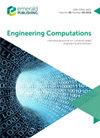High-order discretization–based self-adaptive turbulence eddy simulation for supersonic base flow with PHengLEI software
IF 1.5
4区 工程技术
Q3 COMPUTER SCIENCE, INTERDISCIPLINARY APPLICATIONS
引用次数: 0
Abstract
PurposeThe purpose of the present study is to develop a new numerical framework that can predict the supersonic base flow more accurately, including the development of axisymmetrically separated shear layer and recompression shock. To this end, two aspects are improved and combined, i.e. a newly self-adaptive turbulence eddy simulation (SATES) turbulence modeling method and a high-order discretization numerical scheme. Furthermore, the performance of the new numerical framework within a general-purpose PHengLEI software is assessed in detail.Design/methodology/approachSatisfactory prediction of the supersonic separated shear layer with unsteady wake flow is quite challenging. By using a unified turbulence model called SATES combining high-order accurate discretization numerical schemes, the present study first assesses the performance of newly developed SATES for supersonic axisymmetric separation flows. A high-order finite differencing-based compressible computational fluid dynamics (CFD) code called PHengLEI is developed and several different numerical schemes are used to investigate the effects on shock-turbulence interactions, which include the monotonic upstream-centered scheme for conservation laws (MUSCL), weighted compact nonlinear scheme (WCNS) and hybrid cell-edge and cell-node dissipative compact scheme (HDCS).FindingsCompared with the available experimental data and the numerical predictions, the results of SATES by using high-order accurate WCNS or HDCS schemes agree better with the experiments than the results by using the MUSCL scheme. The WCNS and HDCS can also significantly improve the prediction of flow physics in terms of the instability of the annular shear layer and the evolution of the turbulent wake.Research limitations/implicationsThe small deviations in the recirculation region can be found between the present numerical results and experimental data, which could be caused by the inaccurate incoming boundary layer condition and compressible effects. Therefore, a proper incoming boundary layer condition with turbulent fluctuations and compressibility effects need to be considered to further improve the accuracy of simulations.Practical implicationsThe present study evaluates a high-order discretization-based SATES turbulence model for supersonic separation flows, which is quite valuable for improving the calculation accuracy of aeronautics applications, especially in supersonic conditions.Originality/valueFor the first time, the newly developed SATES turbulence modeling method combining the high-order accurate WCNS or HDCS numerical schemes is implemented on the PHengLEI software and successfully applied for the simulations of supersonic separation flows, and satisfactory results are obtained. The unsteady evolutions of the supersonic annular shear layer are analyzed, and the hairpin vortex structures are found in the simulation.利用 PHengLEI 软件对超音速基底流进行基于高阶离散的自适应湍流涡模拟
本研究的目的是开发一种新的数值框架,以更准确地预测超音速基底流,包括轴对称分离剪切层和再压缩冲击的发展。为此,对两个方面进行了改进和组合,即新的自适应湍流涡模拟(SATES)湍流建模方法和高阶离散化数值方案。此外,还详细评估了新数值框架在通用 PHengLEI 软件中的性能。设计/方法/途径令人满意地预测具有非稳定尾流的超音速分离剪切层具有相当大的挑战性。本研究通过使用一种名为 SATES 的统一湍流模型,结合高阶精确离散数值方案,首先评估了新开发的 SATES 在超音速轴对称分离流中的性能。研究开发了基于高阶有限差分的可压缩计算流体动力学(CFD)代码 PHengLEI,并使用了几种不同的数值方案来研究冲击-湍流相互作用的影响,其中包括单调上游中心守恒律方案(MUSCL)、加权紧凑非线性方案(WCNS)以及单元边缘和单元节点混合耗散紧凑方案(HDCS)。研究结果与现有实验数据和数值预测结果相比,采用高阶精确 WCNS 或 HDCS 方案的 SATES 结果比采用 MUSCL 方案的结果更符合实验结果。WCNS 和 HDCS 还能显著改善环形剪切层的不稳定性和湍流尾流演变方面的流动物理预测。本研究评估了基于高阶离散化的 SATES 湍流模型在超音速分离流中的应用,这对提高航空应用,尤其是超音速条件下的计算精度具有重要价值。原创性/价值首次在 PHengLEI 软件上实现了新开发的结合高阶精确 WCNS 或 HDCS 数值方案的 SATES 湍流建模方法,并成功应用于超音速分离流的模拟,获得了令人满意的结果。分析了超音速环形剪切层的非稳定演化,并在模拟中发现了发夹涡结构。
本文章由计算机程序翻译,如有差异,请以英文原文为准。
求助全文
约1分钟内获得全文
求助全文
来源期刊

Engineering Computations
工程技术-工程:综合
CiteScore
3.40
自引率
6.20%
发文量
61
审稿时长
5 months
期刊介绍:
The journal presents its readers with broad coverage across all branches of engineering and science of the latest development and application of new solution algorithms, innovative numerical methods and/or solution techniques directed at the utilization of computational methods in engineering analysis, engineering design and practice.
For more information visit: http://www.emeraldgrouppublishing.com/ec.htm
 求助内容:
求助内容: 应助结果提醒方式:
应助结果提醒方式:


